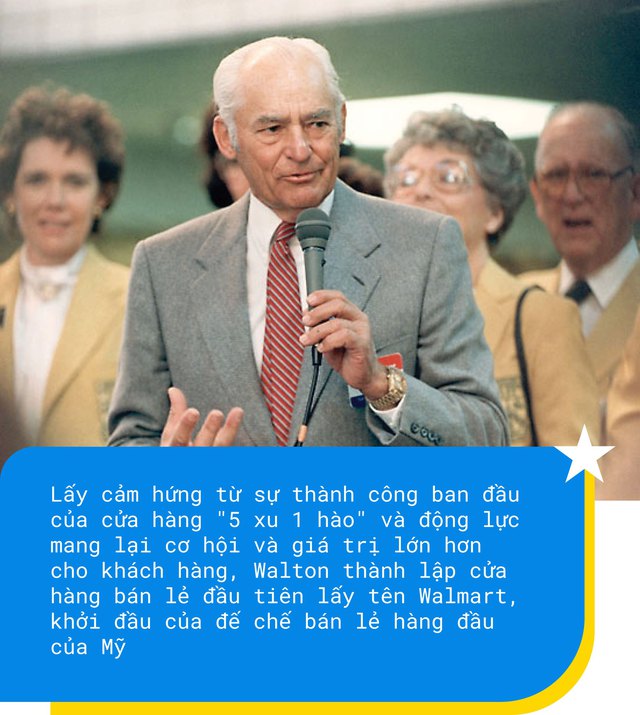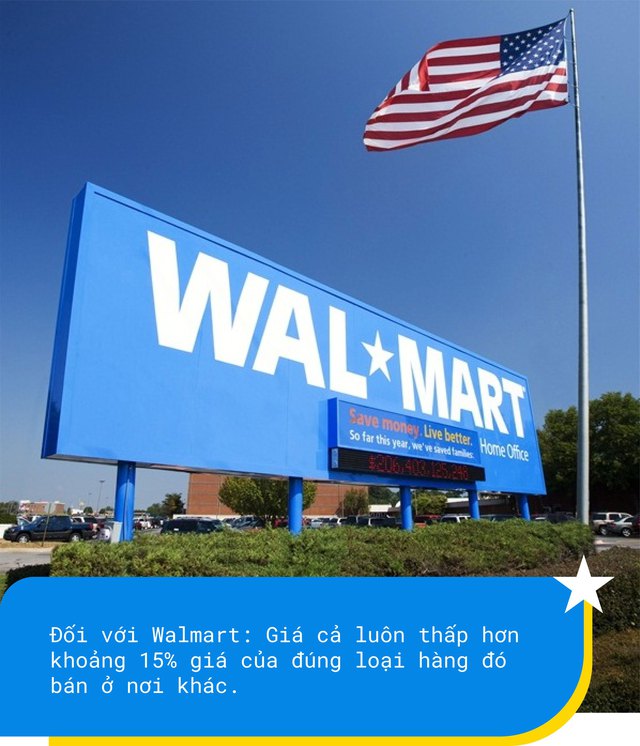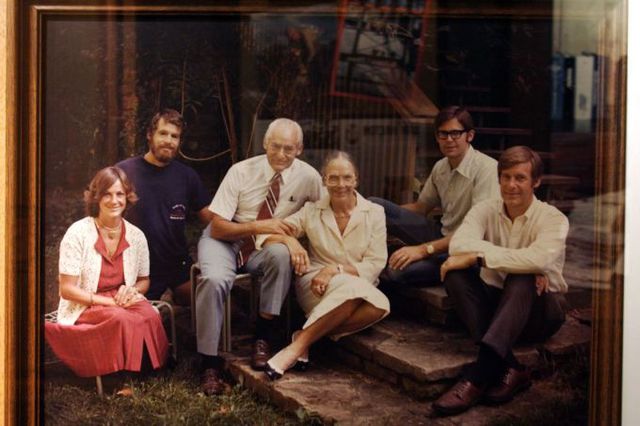From the store ‘5 cents 1 dime’ to the retail king of America, success thanks to selling cheaply and making a lot of profit
In the list of 25 richest families in the world in 2021 due to Bloomberg done, Walton is the family holding the top position. Despite the Covid-19 epidemic, in the 12 months of 2021, the Walton family, who is behind the Walmart hypermarket, earned $ 23 billion, bringing the total fortune to $ 238 billion, nearly $ 100 billion more than the family The second richest person in the world is Mars ($141.9 billion).
According to 2019 statistics of Bloomberg70,000 USD (1.6 billion dong) per minute, 4 million USD (92 billion dong) per hour, 100 million USD per day is an astonishing number of money making speed of this family.
This rich story comes from Sam Walton, the founder of Walmart.

Sam Walton was born into a poor family in a small town in the state of Oklahoma (USA) in 1918. Realizing his role was to support rather than rely on his family, he started delivering deliveries. newspaper from the age of 8 until entering university. During his student days, Sam also experienced enough jobs to support himself as well as pay for his studies.
In 1945, Sam Walton began working at a Ben Franklin dealership in Newport, Arkansas. Here, with the strategy of selling cheap, he helped the dealer’s sales increase from $80,000 to $225,000 in just three years. However, soon after, he had to leave the position of store manager because the owner wanted to take back the shop for his son.
Sam’s next stop was in Bentonville, Arkansas, where he opened the first “5 cents and dime” Walton (Walton Five & Dime) store under the Ben Franklin franchise. Before turning into Walmart, Walton was opened 14 small “5 cents and 1 dime” shops between 1951 and 1962.
Walton’s business model is based on a strong belief that discount stores can thrive in small towns and that if they sell products at the cheapest prices, profits will increase over time. He proposed to the Butler brothers in Ben Franklin to cut profits, but was not approved.
Sam decided to start his own business. Inspired by the early success of his “5 cents 1 dime” store and his drive to bring greater opportunity and value to customers, he founded the first retail store under the Walmart name in 1962 in Rogers, Arkansas.

Just six years later, Walmart was expanded beyond Arkansas. On October 31, 1969, Walmart became a company. In the spring of 1971, Walmart stock was split 100% for the first time and sold on the market for $47.
After acquiring a series of smaller stores and expanding into the states, Walmart took on other areas such as opening pharmacies, auto services, and jewelry stores. Walton’s strategy of lowering product costs is applied to all items from consumer staples to products serving other needs.
On its 18th birthday, Walmart became the fastest-growing company with $1 billion in sales. At that time, Walmart consisted of 276 main stores, 21,000 affiliated stores and retail sales reached 1,248 billion USD.
During the 1980s, Walmart continued to expand throughout the United States and began opening its first department store. Follow New York TimesBy 1991, his supermarket chain had surpassed Sears, Roebuck & Company to become the nation’s largest retailer. As of April 1, 1991, Walmart had 1,735 stores in 42 states, as well as 2 stores in Mexico.

When Walmart started opening a supermarket in a new city, the empire won quickly with a simple but effective tactic: prices were always about 15 percent lower than what the exact same goods were sold elsewhere.
One of Sam Walton’s retail innovations was breaking the decades-long cycle of highs and lows in the prices of consumer products. For example, an item like a Coke beverage would have a typical retail price of say $1.37 for a 2-liter bottle, and be sold at a discount every few weeks for example $1.09 or even $99. coin.
Anyone who regularly shop is familiar with promotions that last only a few days. Wise consumers never pay $1.39 for a bottle of Coke, they just stock up when the price is 99 cents.

These promotional discounts are scheduled long in advance, but they still create volatile consumption cycles. Consumers become addicted to the cheaper price and resist the standard selling price.
Suppliers are also addicted to the output booms triggered by price cuts, but also need to sell at standard prices to maintain a reasonable profit margin. Distribution stores are “crazy” for stocking up on promotions.
To eliminate those things, the head of Walmart wants his sellers to add up all the discounts of the year’s promotions and subtract the entire year’s worth of products. The result is a low and fixed retail price for each day.
To do this, Walmart must make the most of every opportunity to reduce input costs, including operating costs, employee salaries, and product purchase prices. The head of Walmart often arranges for product companies to include the sale price of planned discounts such as Christmas or summer into the price of the whole year. In other words, products on sale in Walmart’s supermarkets are discounted year-round instead of 50% or more at Christmas.
This retail empire even forced suppliers of body deodorants to remove the outer paper container. This initiative helps cut a few cents per product, of which the supplier keeps half, the rest Walmart passes into the hands of the customer. To date, most deodorants are sold in a plastic or glass jar with no outer carton.
It can be said that Sam Walton did not invent retail in the same way that Henry Ford did not invent the automobile. But Ford’s assembly line revolutionized the industry, and Walton’s dogged pursuit of discounting revolutionized America’s service economy. Not only did he change the way Americans shop, but he also promoted the shift of power from the producer to the consumer.

The Internal Revenue Service has drawn the “no more than three generations rich” rule by tracking and studying the top 400 taxpayers from 1992 to 2000, only 13% have been on this list for more than two years. American economist Gregory Clark of the University of California believes that half of the children of upper-class families will eventually descend into the lower social classes.
However, for the Walton family, the people behind the Walmart retail chain have avoided the curse. From the generation of Sam Walton to becoming the richest family in the world in 2019, this family has gone through 3 generations of continuous growth.

Husband and wife Sam, Helen and 4 children Rob, John, Jim, Alice. Photo: Bloomberg
The prosperity of the Walton family has a lot to do with the values of Sam and his wife and their influence on future generations. He and his wife are both typical Americans, born and raised in small towns, with values: value family ties, oppose materialism, value individual striving and charity work…
His family members always get along, they grow up together, and choose a frugal lifestyle. Even when he became America’s richest man in 1985, he was used to wearing a cheap shirt and driving an old pickup truck.
Both he and his wife have strict parenting methods. “I didn’t have test scores below A when I was in school. My children also had to have A test scores,” said Helen – Walton’s wife. And Mr. Sam said: “My children can feel being treated like slaves when they are young. Why not let them do the housework and understand the value of labor.”
Sam’s eldest son Robson recalls: “Back then we were always working at the store, cleaning the floors, cleaning the house. My parents gave me less pocket money than many friends, sometimes making us feel like home. My father also asked me to invest my own money in the store. Of course, this investment later helped me pay for the house.”

Robson Walton is the oldest son in this family. He held the position of president of Walmart until 2015
Before his death, Sam wrote a memoir with the purpose of “archive for his grandchildren and great-grandchildren so that they do not get into the habit of extravagance”.
In 1992, Sam Walton passed away. The Waltons were faced with how to settle their equity and who should take over. Many analysts think the family will choose to sell 50% of the company’s shares for cash.
However, Mr. Sam’s wish is to hope that his children will firmly hold the property. So virtually all of the Walton family fortune was maintained in Walmart stock. Ten years after Sam’s death, Walmart’s market value increased eightfold. David Glass, former CEO of Walmart once commented: “This is not a concept that every family business can have. The Waltons have a vision.”
The second generation of the Walton family was succeeded by President Robson Walton, who steered the Walmart boat for 20 years. He was instrumental in bringing Walmart’s sales revenue up 5 times, to more than 400 billion USD per year, profit also increased 22 billion USD.
During a period of great growth in the hands of the second generation of the Walton family (from 1992 to 2015), Walmart remained the largest retail chain in the United States and this family gradually entered the ranking of the richest families. planet.

Steuart Walton, a lawyer and businessman, son of Jim Walton – a banker, became the heir to the present Walmart
The transfer of power of the retail empire went smoothly. In 2016, Steuart Walton (Jim Walton’s son) was chosen as the next person to steer Walmart. With strategic understanding in the field of e-business, Steuart quickly grew Walmart to more than 11,000 stores in about 30 countries and territories around the world.
Steuart Walton also continues the family tradition with a simple, youthful life. This lawyer and businessman has a deep passion for rock climbing, extreme sports and philanthropy.
With the exception of Steuart Walton, the other young members of this family rarely appear in the press. They choose a secluded, idyllic small-town life like family tradition.
Source: Insider, NYT, Entrepreneur
at Blogtuan.info – Source: Kenh14.Vn – Read the original article here



